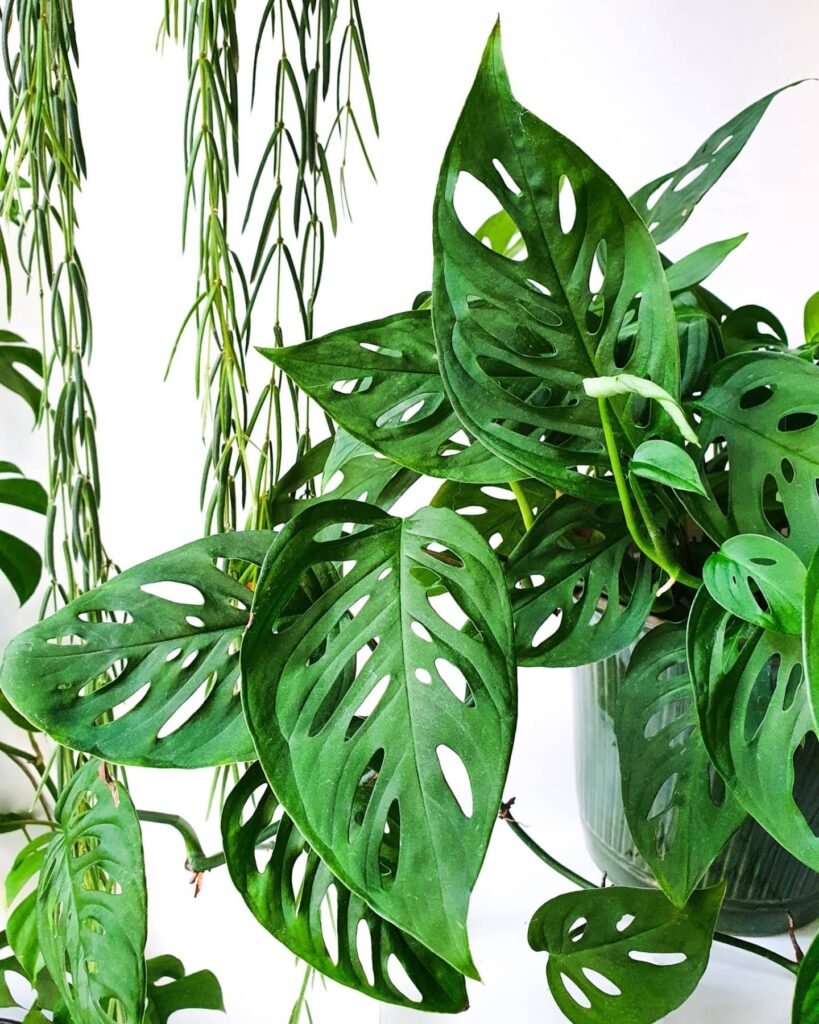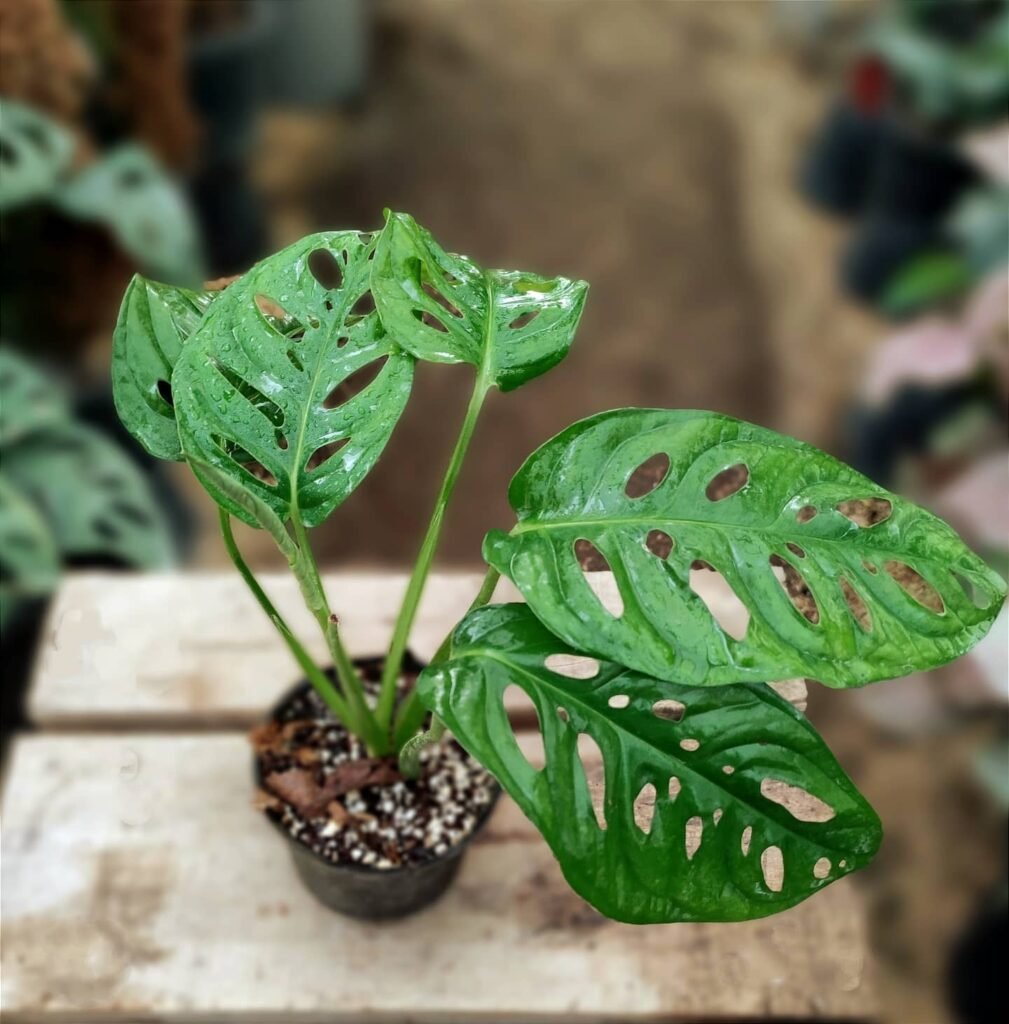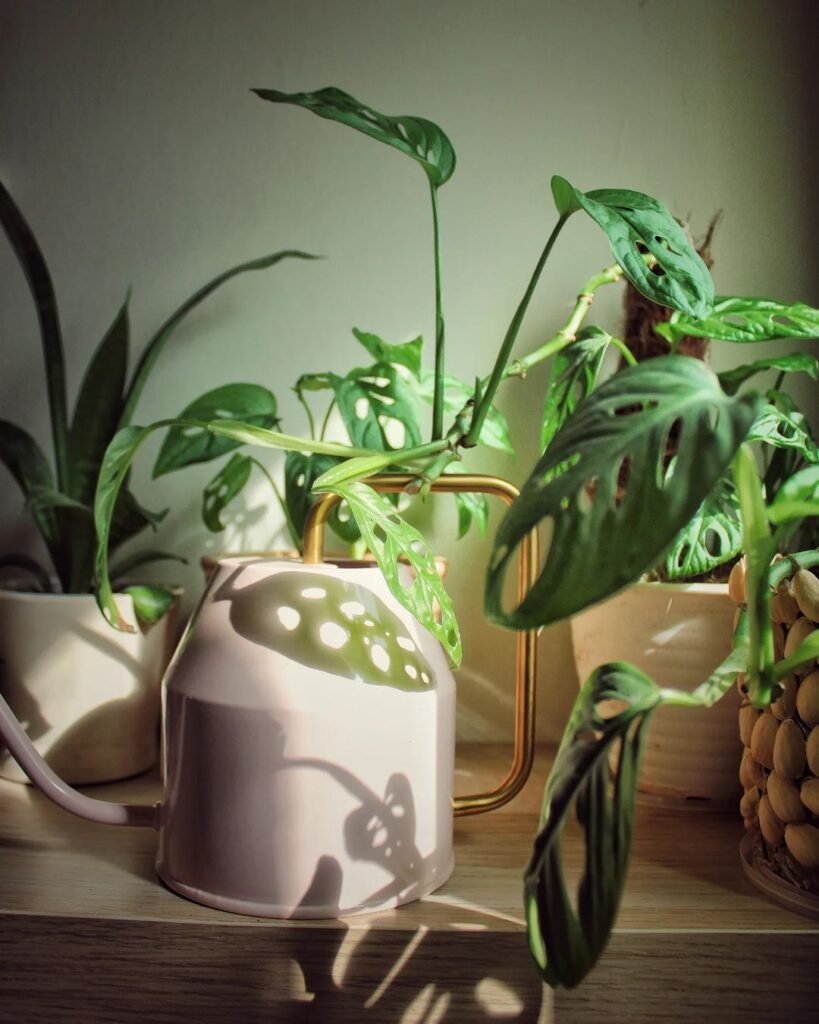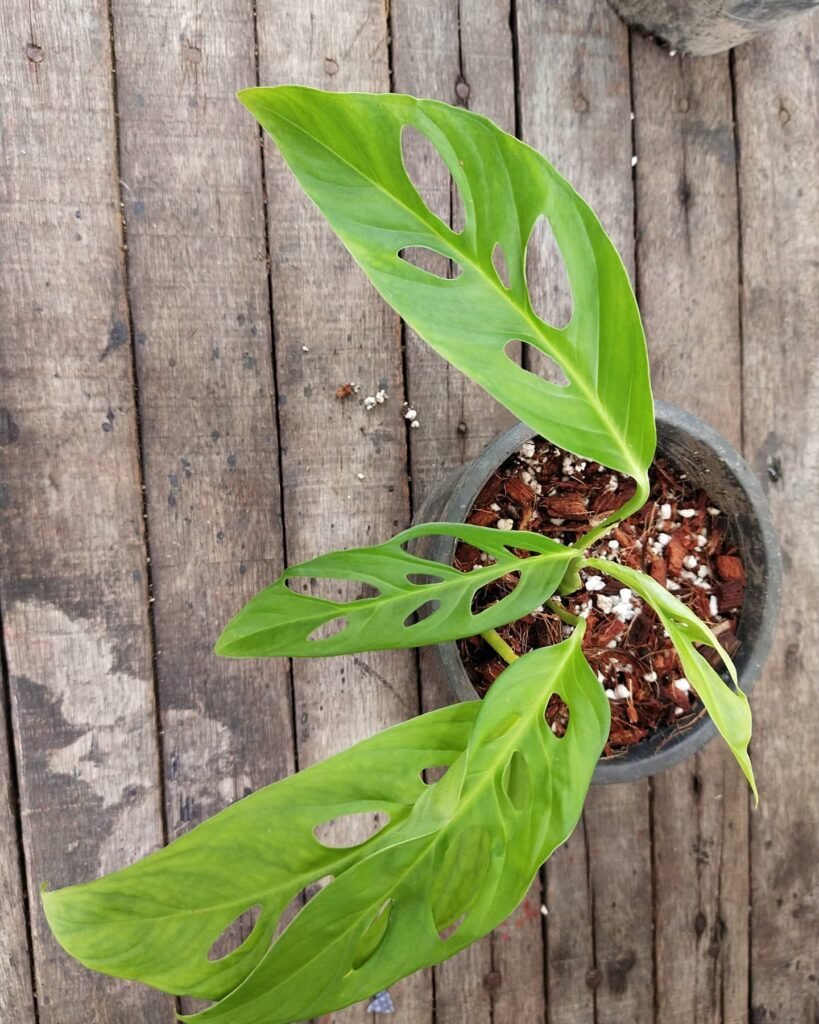Welcome to the captivating world of Monstera adansonii, a charming and versatile member of the Monstera family, native to Central and South America. Known as the Swiss Cheese Vine, it’s celebrated for its unique, holey leaves and easy-going nature. This guide introduces you to the various avatars of Monstera adansonii, including the variegated forms that add an extra layer of visual appeal. Alongside its famous relatives, Monstera Deliciosa, Monstera Albo and Monstera Obliqua, the adansonii brings its distinct charm to the diverse Monstera family.
Appearance of Monstera Adansonii (Swiss Cheese Vine)


Monstera Adansonii, often called Swiss Cheese Vine, is a captivating plant with a unique tropical flair. Originating from Central and South America’s rainforests, it’s known for its distinct features:
- Family: Part of the Araceae family.
- Habitat: Native to tropical regions.
- Leaves: Heart-shaped with distinctive holes or fenestrations.
- Growth: Climbing nature, ideal for trailing or climbing setups.
- Leaf Size: More petite compared to other Monstera varieties.
This plant adds a playful yet elegant touch to indoor spaces, showcasing the enchanting diversity of the Monstera family with its charming and airy foliage.
 Monstera Adansonii, often called the ‘Swiss Cheese Plant,’ is renowned for its unique leaves with natural holes. These holes are not just decorative; they allow light to pass through to the lower leaves in dense rainforests and help the plant withstand strong winds.
Monstera Adansonii, often called the ‘Swiss Cheese Plant,’ is renowned for its unique leaves with natural holes. These holes are not just decorative; they allow light to pass through to the lower leaves in dense rainforests and help the plant withstand strong winds.
Light Requirements for Monstera Adansonii


Proper lighting is essential for Monstera Adansonii, a plant that thrives in conditions that mimic its natural tropical habitat. While it loves brightness, direct sunlight can be too harsh. Here’s how to strike the right balance:
- Bright, Indirect Light: Ideal for promoting growth without risking leaf burn.
- Filtered Light: A location near a window with sheer curtains offers the perfect mix of light and protection.
- Low Light Caution: Insufficient light may slow growth and reduce the distinctiveness of the leaves.
By providing your Monstera Adansonii with the right light environment, you’re setting the stage for a healthy, thriving plant, full of the lush, fenestrated foliage it’s famous for.

Watering Tips for Monstera Adansonii


Watering your Monstera Adansonii correctly is vital for its well-being. Here’s how to achieve the perfect balance:
- Check Soil Dryness: Water when the top inch of the soil feels dry to the touch.
- Thorough Watering: Soak the soil until water runs out of the drainage holes, ensuring deep hydration.
- Avoid Overwatering: Overwatering can lead to root rot, so it’s important not to let the plant sit in water.
- Seasonal Adjustments: Reduce watering in the colder months when the plant’s growth slows.
By following these watering tips, your Monstera Adansonii will maintain its health and vitality, showcasing lush, vibrant leaves. Proper watering ensures the plant gets just the right amount of moisture to mimic its natural tropical environment.

Fertilizing and Soil for Monstera Adansonii


Fertilizing and choosing the right soil are crucial for the health of your Monstera Adansonii. This plant flourishes in soil that mimics its natural environment and benefits from regular, balanced feeding.
Here’s a quick guide:
| Aspect | Details |
|---|---|
| Soil Type | Well-draining, peat-based mix. |
| Fertilizer | Balanced, water-soluble, every 2-4 weeks in growing season. |
With the correct soil and regular fertilization, your Monstera Adansonii will have the nutrients it needs to grow lush and healthy. This care ensures your plant will continue to thrive and bring its unique tropical beauty to your space.

Pruning and Maintenance for Monstera Adansonii


Pruning and maintenance are essential for keeping your Monstera Adansonii healthy and attractive:
- Regular Pruning: Trim any yellowed or dead leaves to promote new growth and maintain a tidy appearance.
- Dust Cleaning: Gently clean the leaves with a damp cloth to remove dust and enhance photosynthesis.
- Support Structures: Provide support for climbing, such as a moss pole or trellis, to encourage vertical growth.
- Pest Checks: Regularly inspect for pests like spider mites and treat promptly if needed.
Effective pruning and maintenance not only keep your Monstera Adansonii looking its best but also support its overall health and well-being. These care steps ensure it continues to be a stunning addition to your indoor garden.

Propagating Monstera Adansonii (Swiss Cheese Vine)


Propagating Monstera Adansonii is a rewarding way to expand your plant collection:
- Stem Cuttings: Choose a healthy section with at least one node and a few leaves.
- Rooting Medium: Place the cutting in water, sphagnum moss, or soil. Ensure the node is in contact with the medium.
- Indirect Light: Keep the cutting in a spot with bright, indirect light.
- Patience: Wait for roots to develop, which can take a few weeks.
Propagating Monstera Adansonii allows you to create new plants, perfect for sharing or adding to different areas of your home. With patience and the right conditions, you can watch a new Swiss Cheese Vine flourish from a single cutting.

Repotting Tips for Monstera Adansonii
Repotting Monstera Adansonii (Swiss Cheese Vine) is an important part of its care, especially as it grows:
- Timing: Repot every 2-3 years, or when roots start to crowd.
- Pot Selection: Choose a pot slightly larger than the current one, with good drainage.
- Soil Mix: Use a well-draining potting mix suitable for aroids.
- Gentle Handling: Be careful not to damage the roots during repotting.
Repotting gives your Monstera Adansonii fresh soil and more room to grow, supporting its overall health and vigor. This process rejuvenates your plant, encouraging continued growth and lush foliage.
 Monstera Adansonii isn’t just a pretty face in the plant world. This climbing plant has aerial roots that help it cling and climb in its natural habitat. In homes, these roots can be trained to grow on moss poles, showcasing its jungle vibes right in your living room!
Monstera Adansonii isn’t just a pretty face in the plant world. This climbing plant has aerial roots that help it cling and climb in its natural habitat. In homes, these roots can be trained to grow on moss poles, showcasing its jungle vibes right in your living room!
Helpful Videos About Monstera Adansonii
Check out these great videos on Monstera Adansonii care. They’re easy to follow and perfect for anyone wanting to learn more about this plant. Whether you’re just starting out or looking to up your plant care game, these guides will offer invaluable insights.
- How I grew a large Monstera adansonii from a small cutting – Plant Spotlight
- How To Care For Monstera Adansonii
Frequently Asked Questions about Monstera Adansonii

Got questions about your Monstera Adansonii? This FAQ section is here to help. We’ve gathered the most common queries about caring for this popular houseplant and provided detailed answers. Whether you’re a first-time plant parent or a seasoned gardener, you’ll find useful tips and insights.
A tropical plant known for its distinctive holey leaves.
Bright, indirect light is best.
Allow the top inch of soil to dry out between waterings.
Well-draining potting mix.
Monthly during the growing season, using a balanced fertilizer.
Trim to remove dead or yellowing leaves.
Use stem cuttings with nodes.
Every 2-3 years or when roots outgrow the pot.
Yes, it’s an ideal indoor plant.
Common pests include spider mites and mealybugs.
Yes, it’s toxic if ingested.
Possibly due to overwatering or poor drainage.
Moderate growth rate.
Prefers high humidity but can tolerate average indoor levels.
We hope these FAQs help you care for your Monstera Adansonii. If you have more questions or need specific advice, feel free to leave them in the comments. Let’s keep those Swiss Cheese Vines healthy and happy!

